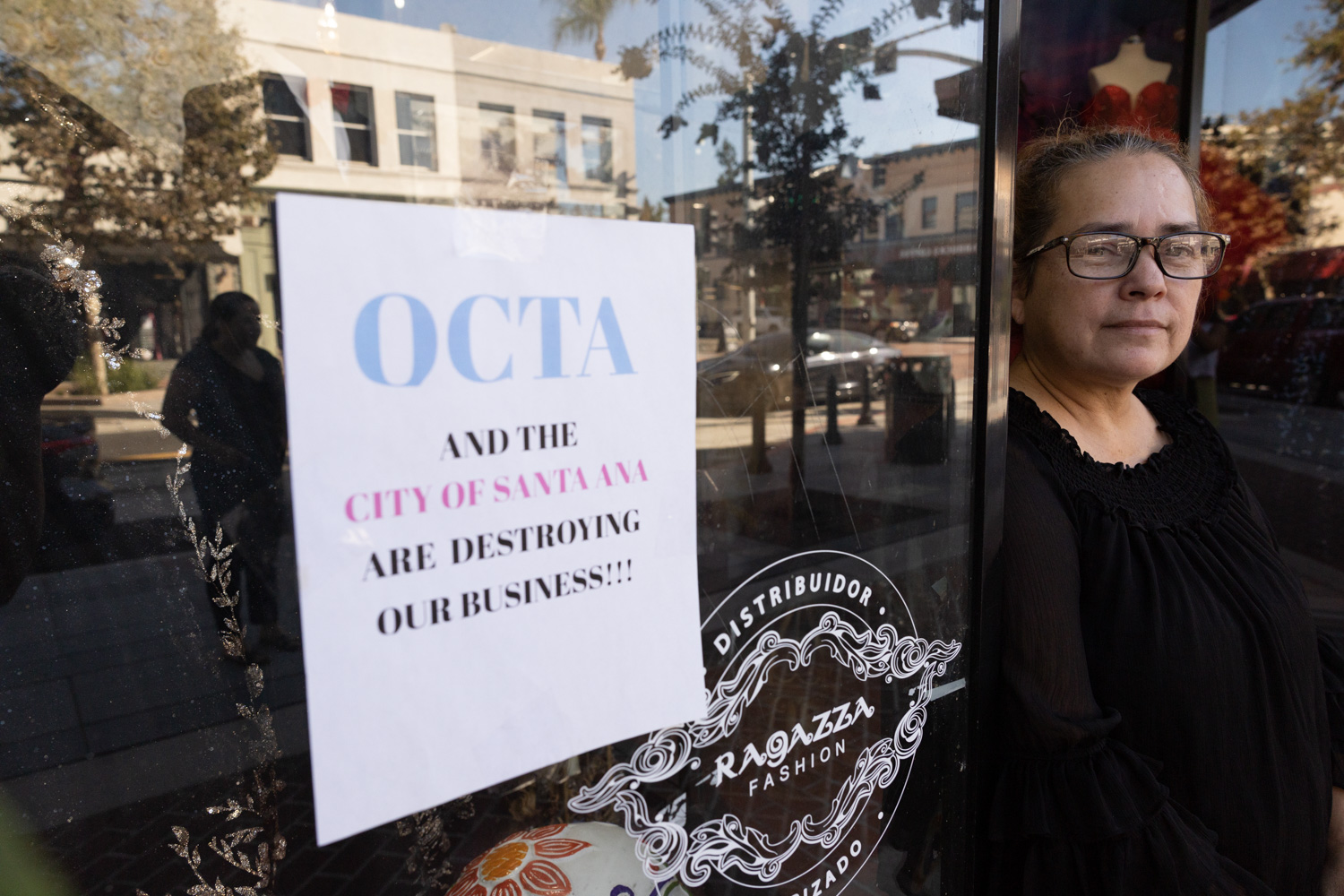Orange County leaders are celebrating as they’re about to open a long overdue street car railway in Santa Ana – but many of the business owners who live and work right next to it say the project wrecked their businesses and disrupted their lives.
“To all the politicians who approved this, truthfully, with all respect, I hope you do not get offended; this is the stupidest thing that could have been done,” said Minerva Alvarez, who’s owned a dress shop for over 32 years in downtown Santa Ana. “It has brought the worst for us, a lot of my friends have had to close their businesses down.”
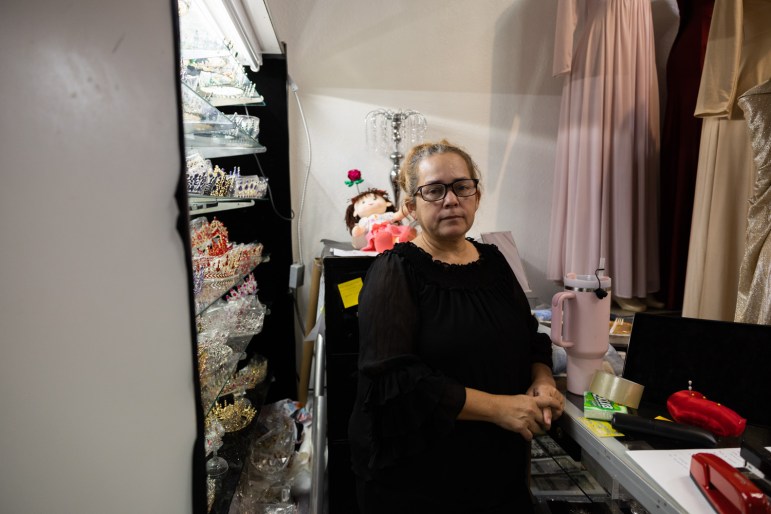 Minerva Alvarez has been in business in downtown Santa Ana over three decades. Credit: JULIE LEOPO, Voice of OC
Minerva Alvarez has been in business in downtown Santa Ana over three decades. Credit: JULIE LEOPO, Voice of OC
A county grand jury also took a look at the issue earlier this year and questioned why it took over a decade to build a rail line that stretches just over four miles at a cost of over $156 million per mile, with no clear answer on who will be riding on it.
[Read: How Did the Santa Ana Streetcar Construction End up Costing Over $150 Million Per Mile?]
“Despite (Orange County Transportation Authority)’s oft-repeated statement that ‘this is what Santa Ana wanted,’ the Grand Jury is uncertain that Santa Ana would have been as eager to proceed with this project had the city known there would be this level of construction delays, continuing cost overruns, monetary damages to local businesses, and an unknown completion date,” jurors wrote.
Leaders at the county transportation agency have continued to defend the project for over a decade, arguing it was what the people wanted in statements and interviews including county Supervisor Doug Chaffee, the current chair of the agency’s board.
“The businesses wanted the route where it is,” Chaffee said in a Friday interview. “This was where people seemed to want it, particularly the businesses.”
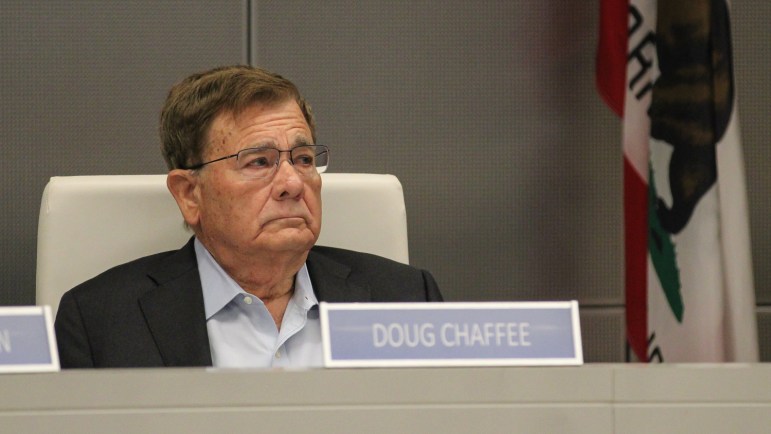 Supervisor Doug Chaffee at the OCTA Board of Directors meeting on April 8, 2024. Credit: ERIKA TAYLOR, Voice of OC
Supervisor Doug Chaffee at the OCTA Board of Directors meeting on April 8, 2024. Credit: ERIKA TAYLOR, Voice of OC
But the people who own businesses next door paint a much different picture.
Businesses Close Amid Construction and Pandemic
While conversations about a rail car running down Fourth Street started in 2004, construction crews didn’t break ground until 2018.
Construction quickly ran into problems, including the 2020 pandemic closures, a lawsuit between the lead contractor and the county, inaccurate utility survey maps and the discovery of an unknown Native American burial ground on the construction site.
The first piece of actual track wasn’t laid down until the final days of 2020, when the agency staff claimed it would be up and running by 2022.
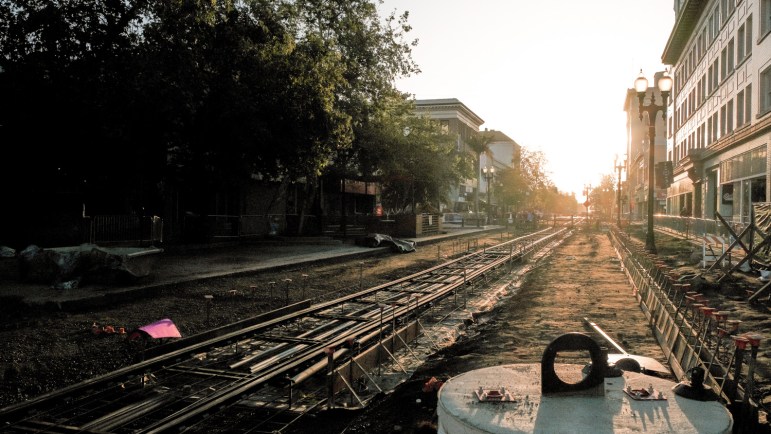 Orange County Streetcar construction site at Fourth Street in downtown Santa Ana on March 30, 2022. Credit: OMAR SANCHEZ, Voice of OC
Orange County Streetcar construction site at Fourth Street in downtown Santa Ana on March 30, 2022. Credit: OMAR SANCHEZ, Voice of OC
Now, the rail line isn’t set to open until spring 2026.
Many of the business owners who are still there say the construction has been one of the hardest periods of their lives.
Carlos Rodriguez, who’s run his own computer business in downtown Santa Ana since 2003, said the individual merchants never heard from OCTA about the closures and that the streetcar has cut down the amount of parking available near his shop while complicating traffic.
“I don’t know what to expect now, because the streetcar is taking too long, and customers are going everywhere but here,” Rodriguez said in a September interview. “We were closed for months during the construction, then we would open and no one would come.”
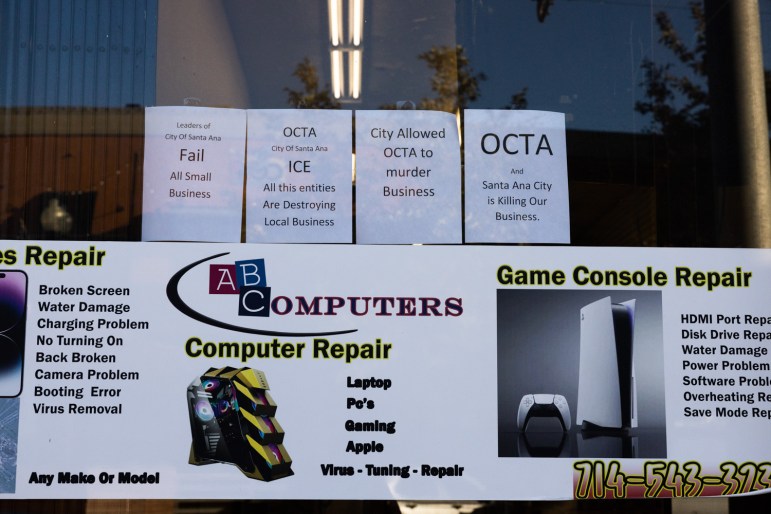 Printed out signs are visible across multiple different storefronts in downtown Santa Ana. Credit: JULIE LEOPO, Voice of OC
Printed out signs are visible across multiple different storefronts in downtown Santa Ana. Credit: JULIE LEOPO, Voice of OC
Some businesses didn’t survive to see the rail line open.
Maria Perez saved up for years to open her own store in downtown Santa Ana, but was ultimately forced to close in 2023 due to the construction and pandemic closures.
Perez now operates a smaller version of her juice-and-bagel shop at another restaurant in downtown Santa Ana.
[Read: Battling to Survive Santa Ana’s Street Car]
“They didn’t contemplate the economical disaster that it created to the businesses of Fourth Street and in these moments we are an economic disaster provoked by the construction of the train,” Perez said at the Santa Ana City Council’s April 18, 2023 meeting.
Promise of a Bright Future Questioned
In May, county transit leaders celebrated the arrival of the rail line’s first rail car, hosting a public exhibition of the vehicle that can hold over 200 people and hailing it as the next big thing in Orange County.
Chaffee praised the rail line, noting that while the construction was a painful process it now would hopefully turn around and invited people to take a ride on it when it opens.
“Time may tell it is worth it. Who knows. We’re excited about actually getting it going after all we’ve been through,” Chaffee said. “We think in time it will be appreciated.”
County Supervisor Vicente Sarmiento, a former Santa Ana mayor who voted against the project when he was on city council, declined an interview but issued a short statement on Friday acknowledging the hardship businesses faced and highlighting the path ahead.
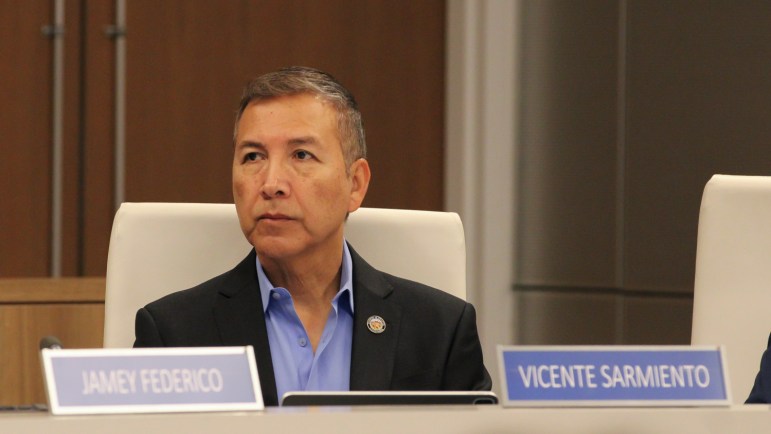 Supervisor Vicente Sarmiento at the OCTA Board of Directors meeting on April 8, 2024. Credit: ERIKA TAYLOR, Voice of OC
Supervisor Vicente Sarmiento at the OCTA Board of Directors meeting on April 8, 2024. Credit: ERIKA TAYLOR, Voice of OC
“Now that the system is complete in the area, we must do the additional work to ensure it operates as a true public system connected to other transportation options, that it benefits the businesses along the route, and that it operates to serve the needs of residents in the area,” Sarmiento wrote.
OCTA staff also claimed the project was called for by Santa Ana.
“In 2014, the Santa Ana City Council unanimously adopted the Locally Preferred Alternative, including route, station locations, and vehicle type, after a transparent process with extensive public input,” wrote agency spokesperson Eric Carpenter in a Friday statement.
But the project was not approved unanimously, with four out of seven council members approving it in Aug. 2014, while the other three members were absent.
Then Mayor Miguel Pulido and Councilmembers Angelica Amezcua, P. David Benavides and Michele Martinez were present and voted for the project, while then-Councilmembers Roman Reyna, Vicente Sarmiento and Sal Tinajero were absent.
Some residents, business owners and union leaders praised the proposal while some residents had concerns it could erase the history of downtown.
“We want to continue the latino influence downtown. We don’t want to be lost,” said Sam Romero, a longtime local activist known for speaking out for small businesses, at that meeting. “A lot of us are concerned we may be losing that.”
A city staff report from that meeting noted just 30 people reached out to the city before that to talk about the project publicly while they were looking for input on the route.
Shelsye Alvarez, owner of the Perfect Day shop and Minerva’s daughter, grew up on Fourth Street and said the construction has hollowed out what was once a vibrant community.
“I was in the womb when she started here,” Shelsye said in an interview last month. “It was great, the culture, it was super lively. And that’s what we hope this area comes back to be.”
 Shelsye Alvarez, owner of the Perfect Day shop in downtown Santa Ana on Sept. 30, 2025. Credit: JULIE LEOPO, Voice of OC
Shelsye Alvarez, owner of the Perfect Day shop in downtown Santa Ana on Sept. 30, 2025. Credit: JULIE LEOPO, Voice of OC
She also pointed out how most of the foot traffic they once had now never comes through, and that even their long-time customers weren’t sure they’d survive.
“We had to make sure to tell our clientele, ‘hey, we are here. We’re not leaving, we’re not closing. Please trust us and come in’ and you know,” Shelsye said. “We haven’t seen anything that was promised from this project. There has been no proof. Nothing that we were promised is visible today. So I think it was a waste of money.”
Transportation Leaders Ignore Recommended Improvements
It’s also unclear if any future transportation projects will go any smoother for impacted businesses.
Grand jurors recommended a series of changes for potential future projects, including a broader outreach campaign and possibly setting up a fund to support businesses who were impacted by street closures.
But transportation authority CEO Darrell Johnson brushed off their concerns in the agency’s response to the grand jury’s report, arguing that they did a lot to support local businesses, including radio and newspaper advertising along with a program dubbed Eat, Shop, Play.
“OCTA proactively launched and sustained multiple initiatives to assist affected businesses,” Johnson wrote. “These efforts reflect OCTA’s ongoing commitment to supporting local businesses and maintaining open communication with the community throughout construction.”
The agency’s response also dubbed the proposal of a fund for businesses as “unreasonable.”
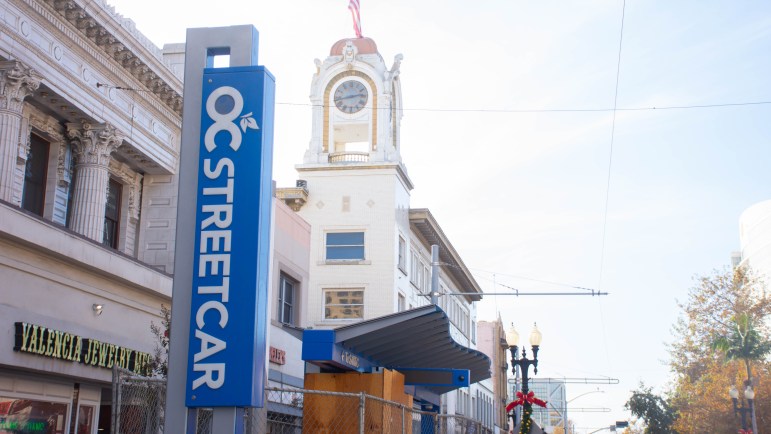 A OC Streetcar station faces the iconic Spurgeon clock tower along Fourth St. in downtown Santa Ana on Nov. 16, 2024. Credit: QUINCI CARTMELL, Voice of OC
A OC Streetcar station faces the iconic Spurgeon clock tower along Fourth St. in downtown Santa Ana on Nov. 16, 2024. Credit: QUINCI CARTMELL, Voice of OC
“Direct financial assistance to individual businesses is restricted under both federal and state law,” Johnson wrote. “In light of those findings, the Board of Directors directed staff to continue pursuing non-financial mitigation strategies, including support for marketing and promotional activities…this recommendation cannot be implemented.”
But grand jurors highlighted how the Los Angeles Metro Transit Authority offered their own fund for businesses who were impacted during construction of projects like the Crenshaw/LAX Transit Project, annually handing out over $10 million to businesses impacted by construction.
Chaffee said he was unaware of how LA was able to fund that program, but said that it wasn’t a possibility in Orange County.
When asked if he had any statement for businesses that closed due to the construction, he said “I don’t think any of them were required to shut down.”
“That was maybe more of their concern they weren’t getting business because of a lack of access,” Chaffee said. “I’m not sure who are gone. Some may have closed and are reopening. I’m not a Santa Ana resident…I don’t know whose come and gone but I think it’s unfortunate.”
“Each would have a particular circumstance. I’d rather address each circumstance separately so as to understand,” he continued. “I don’t know whether they went into retirement or relocated. I don’t have that information.”
Mimi Mar, who’s owned and operated a Pizza Press in downtown Santa Ana for over seven years, invested over half a million dollars in her business and said the rail car construction has “inflicted extreme financial turmoil,” in a statement earlier this month.
“While acknowledging the financial assistance provided by the City and County, it is unequivocally stated that these funds were woefully inadequate,” she wrote. “The aid, though appreciated, was a temporary band-aid on a gaping wound, failing to address the systemic financial hemorrhage caused by the Streetcar project.”
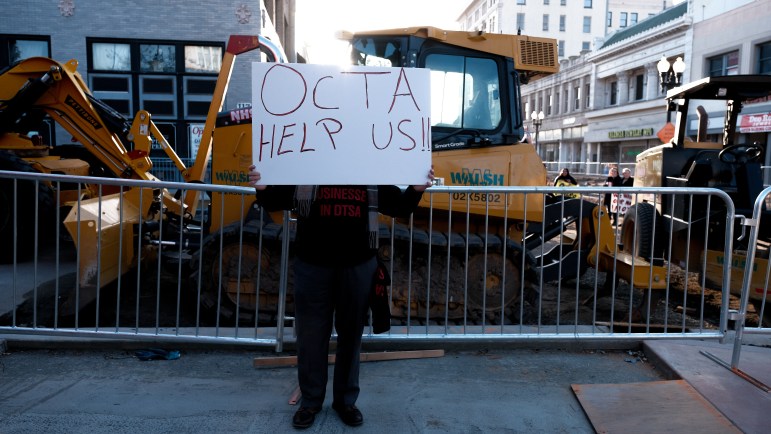 “It’s like a war happening without arms.” Javier Meneses of Latino American Services in downtown Santa Ana said that the Orange County Transportation Authority (OCTA) did not ask for the input of small business owners regarding the OC Streetcar project before beginning construction. March 30, 2022. Credit: OMAR SANCHEZ, Voice of OC
“It’s like a war happening without arms.” Javier Meneses of Latino American Services in downtown Santa Ana said that the Orange County Transportation Authority (OCTA) did not ask for the input of small business owners regarding the OC Streetcar project before beginning construction. March 30, 2022. Credit: OMAR SANCHEZ, Voice of OC
She also noted that not one entrepreneurs she spoke with supported the project, and asked the leaders who approved the project one question.
“How could a project of such immense scale and potential for disruption be consciously approved without a thorough and empathetic consideration of its profound effect on the very livelihoods of the business owners it claimed to serve?” Mar wrote.
“The lack of foresight and empathy has not only crippled businesses but has also eroded the trust between the local government, transportation authorities, and the vital small business community that forms the backbone of downtown Santa Ana.”
Noah Biesiada is a Voice of OC reporter. Contact him at nbiesiada@voiceofoc.org.
Related

